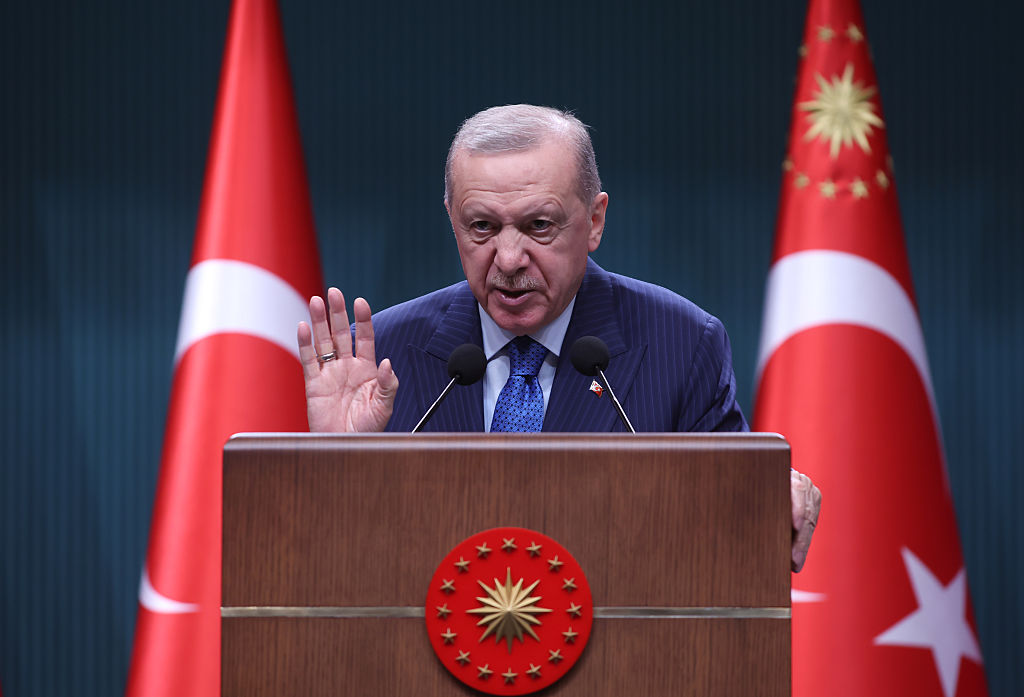“Goddess, sing of the cataclysmic wrath,” opens Emily Wilson’s new translation of The Iliad. The goddess Homer summoned isn’t named, but it is usually assumed he meant Calliope, the muse of epic poetry —and much later, circus music. But Homer might have meant Lyssa, the Greek goddess of mad rage and frenzy. She was well known to the ancients. The Romans called her Furor or Rabies — which gets the idea across fairly well. The Norse had two versions: Odr, who represented fury and frenzy, and Fenrir, a giant wolf who represents uncontrollable savagery.
By whatever name she may have been called, Lyssa appears to have been active in human affairs for a very long time. A five-thousand-year-old archaeological site in northern Spain, the San Juan ante Portam Latinam rock shelter, revealed a mass grave of more than 300 people, mostly young men killed by blows to the head, others with arrowheads embedded in them. This is Lyssa’s stone-age work, and the only secure evidence we have of large-scale warfare before the invention of metal. The massacre occurred more than 2,000 years before the fall of Troy.
It has fallen out of fashion to speak of the savagery of our ancestors or even to mention “the uncivilized races of mankind.” But the truth is that tribes have been visiting atrocities on one another for as long as our species has existed. While we don’t have definitive proof of what happened to the Neanderthals, the Denisovians, Homo floresiensis, and dozens of others extinct relatives, we have a pretty good idea of where they went. And in more recent times, we have even better ideas of how the native peoples of North Africa and Africa conducted their foreign policies. “Live and let live” was not the guiding principle.
For the last twenty-five years or so, I have been writing (off and on) on the topic of anger in American life. In one of my books, A Bee in the Mouth, I examined a revolution in American attitudes towards anger. From very early in the English colonization through World War Two, Americans regarded anger as a dangerous force, to be kept under control. The admirable man (and woman) was someone who, when provoked beyond all reason, still kept his cool. He might have to fight, but he would fight with a clean purpose. To be angry beyond self-control was a sign of weakness. Gary Cooper in High Noon was an ideal type; Edward G. Robinson’s character Rico in Little Caesar was the antitype: bloodthirsty, self-pitying, consumed with resentful pride.
All this went into reverse in the years after World War Two. It was an era in which our cultural elites discovered both existentialism and psychoanalysis. Existentialism lauded the “authenticity” of unfettered anger. Psychoanalysis taught us that repressing anger is “unhealthy.” Other factors came into play as well: grievance-based protest politics, the sexual revolution, the Sixties, et cetera. Not suddenly or instantaneously, but gradually and step by step, Americans began to feel that anger could be a good thing. It was empowering to the individual and a tool for “social justice.” It was a scourge of the “hypocrisy” of the middleclass. It was “liberating.”
I wrote my “bee” book during the George W. Bush years, when there was plenty of ostentatious anger on the left. But it was anger that I characterized as “performative.” It was for show. It seldom was the prelude to actual violence. I deliberately set aside much of the academic writing on anger which focused on anger in the context of violence. It seemed important to recognize anger as a verbal thing that fed into the shaping of personal character and the cultivation of a lifestyle in which displays of anger were key to a certain kind of positive social recognition.
Years later I returned to the topic in a book titled Wrath: America Enraged, which picked up the story with the Capitol Hill riot on January 6, 2021. The verbal anger of fifteen years earlier had plainly fed on itself and intensified, but not only intensified. It had become filled with unappeasable rage — on both sides of the political divisions. And it had precipitated the kinds of showdowns in which people could be — and were in fact — killed. The George Floyd riots in the summer of 2020 were part of the enunciation that street violence, murder, and looting were to be accepted by many in authority as “legitimate” expressions of anger over racial injustice and… whatever.
I’ve been saying for a long time that we would pay a cultural price for abandoning that old ethic of self-control for the pleasures of angry self-expression. A little bit of that indulgence may have been a good thing, but when you relinquish the ideal of mastering your emotions in favor of indulging them, where exactly do you stop?
I would say it took civilization several thousand years to learn how a society could master its darkest impulses. The ancient Greeks failed the test, as anyone who reads the blood-soaked pages of the Peloponnesian Wars knows well. And learning how to suppress rage was never a guarantee that the monsters would always stay away in the forest or under the bed. Nazism and communism showed us that the demonic was always there waiting for its opportunity to burn civilization to the ground and to turn otherwise decent people into murderous brutes.
Which brings me to today. I am not speaking about the intoxicated evil of the young men unleashed by Hamas on Israeli civilians. Those killers are not a case study in the breakdown of civilization, but rather instances of the atavistic savagery of people raised to be piranhas: frenzied, gleeful, sated only by pure evil. They provide no lesson in the breakdown of the norms of self-control, since their only measure is loyalty to a fanatical cause.
Rather, when I speak of today I mean something else: the legions of American (and not just American) young people who justify the atrocities committed by Hamas as a legitimate action against “settler colonialist” Jews. There is something new here. This isn’t anger as a prelude to violence. It is anger that is conjured in the aftermath of violence. And like other forms of anger, it feeds on itself and escalates. What began as a handful of statements by student activists who followed instructions from “Students for Justice in Palestine” soon became a popular cause. It snowballed by drawing on several tributaries. One was generational. Extolling Hamas became a way for the current generation of college students to issue a blanket “F-you!” to the rest of society.
It was also a moment to take full ownership of the anti-civilizational conceit in which an entire generation had been marinated from kindergarten on. They learned that the West is a totally rotten, corrupt place, that gained its ascendency by stealing resources from indigenous people and then ruthlessly exploiting the environment by burning fossil fuels and handing over to the next generation a planet that will wither under the curse of global warming. Praising Hamas is a way to bundle all of these discontents and antipathies into one giant outrage. It screams, “I hate your civilization. You deserve to be raped, beheaded, tortured, roasted and hauled into underground caves.” This is the proper response to the crimes you have committed against our purity and innocence.
The young people who think and say these things are, tragically, deluded. Their heads are filled with falsehoods. In place of a grasp of history they the mythology of Howard Zinn, Edward Said, Ibram X. Kendi and Nikole Hannah-Jones. In place of science, they have the mythology of Al Gore, Michael Mann, Greta Thunberg, Bill McKibben and the IPPC. They have grown up in the bubble of social media in which their capacity for critical thinking has been hijacked by their exquisite sensitivity to group conformity. Their moral formation has been blotted out by endless reassurance that what counts is “social justice.” Their sense of a morally culpable individual self has been dimmed to the pilot light of submission to ideological orthodoxy. Whatever challenges the orthodoxy is cause for outrage.
This is not to say that their anger is somehow unreal. It is perfectly real because it is the only emotion which has been positively reinforced through their lives. Optimism about their lives to come has been ground to the dust of apocalyptic fantasy. It is cartoon nihilism that exhilarates them.
I say all this as though I am indicting a whole generation, which isn’t really my intention. I know plenty of young people who shun this worldview, or at least try to. Their problem is that their education has given them precious little with which to resist. Indoctrination on climate catastrophism, Critical Race Theory (packaged as “diversity, equity and inclusion”), anti-colonialism, LGBTQ doctrines and transgenderism, leaves them with only the sketchiest of ideas about the civilization they are destined to inherit.
Those who are not seized by the frenzy may intuit that radical despair is ill-founded, but they do not know how to confront it head-on. They don’t have the facts. Say the name “Columbus,” and they automatically think “genocide.” Say “Jefferson” and they automatically think “Sally Hemings.” They can’t help themselves. Their education has equipped them with reflexes, not knowledge, and the reflexes themselves are always dismissive sneers aimed at discrediting the achievements of our civilization’s builders. To escape from this requires a huge effort of will to overturn the authority of their teachers, who are in many cases just the unwitting conveyors of the conventional leftism transmitted in schools of education,
We are thus faced as a society with a generation the most active and vocal members of which hate their own society. That hate is now playing itself out in antisemitism, bloodlust by proxy, protest theatrics and a self-granted license to attack anyone who gets in their way. The adults who should be standing up to this — professors and college officials first of all — are in many cases cowering. They temporize with the terrorist allies.
What are we to do? To start with, we are to recognize how very thin the line is between civilization and barbarity. Lyssa is always waiting for her moment. Fenrir is always ready to break his chain. Civilization isn’t imperishable. It perishes when we let it. The San Juan ante Portam Latinam rock shelter is always waiting.
That chilling recognition must be followed with the truly hard work of restoring substance to American education. Therein lies a task for parents to wrest control of school boards, and citizens to recapture the universities for the public good. As to what to do with the pathetic college students now reveling in their identification with euphoric executioners, we have no recourse but to let them settle to the bottom where they belong. They have chosen self-exile from civilized life and that should be the order of the day. Some will find their way back, but that won’t happen by indulging them with rational debate, tenderheartedness, tolerance, or forgiveness. They have cast their lot with Lyssa and are, by all accounts, proud of it. The best we can hope for is the moment when they look in the mirror and are appalled.


























Leave a Reply